Drum Transcription
Drum transcription is the process of converting drum audio recordings into drum notation or MIDI data.
Papers and Code
The Inverse Drum Machine: Source Separation Through Joint Transcription and Analysis-by-Synthesis
May 06, 2025We introduce the Inverse Drum Machine (IDM), a novel approach to drum source separation that combines analysis-by-synthesis with deep learning. Unlike recent supervised methods that rely on isolated stems, IDM requires only transcription annotations. It jointly optimizes automatic drum transcription and one-shot drum sample synthesis in an end-to-end framework. By convolving synthesized one-shot samples with estimated onsets-mimicking a drum machine-IDM reconstructs individual drum stems and trains a neural network to match the original mixture. Evaluations on the StemGMD dataset show that IDM achieves separation performance on par with state-of-the-art supervised methods, while substantially outperforming matrix decomposition baselines.
Music Tempo Estimation on Solo Instrumental Performance
Apr 25, 2025Recently, automatic music transcription has made it possible to convert musical audio into accurate MIDI. However, the resulting MIDI lacks music notations such as tempo, which hinders its conversion into sheet music. In this paper, we investigate state-of-the-art tempo estimation techniques and evaluate their performance on solo instrumental music. These include temporal convolutional network (TCN) and recurrent neural network (RNN) models that are pretrained on massive of mixed vocals and instrumental music, as well as TCN models trained specifically with solo instrumental performances. Through evaluations on drum, guitar, and classical piano datasets, our TCN models with the new training scheme achieved the best performance. Our newly trained TCN model increases the Acc1 metric by 38.6% for guitar tempo estimation, compared to the pretrained TCN model with an Acc1 of 61.1%. Although our trained TCN model is twice as accurate as the pretrained TCN model in estimating classical piano tempo, its Acc1 is only 50.9%. To improve the performance of deep learning models, we investigate their combinations with various post-processing methods. These post-processing techniques effectively enhance the performance of deep learning models when they struggle to estimate the tempo of specific instruments.
Meta-learning-based percussion transcription and $t\bar{a}la$ identification from low-resource audio
Jan 08, 2025



This study introduces a meta-learning-based approach for low-resource Tabla Stroke Transcription (TST) and $t\bar{a}la$ identification in Hindustani classical music. Using Model-Agnostic Meta-Learning (MAML), we address the challenge of limited annotated datasets, enabling rapid adaptation to new tasks with minimal data. The method is validated across various datasets, including tabla solo and concert recordings, demonstrating robustness in polyphonic audio scenarios. We propose two novel $t\bar{a}la$ identification techniques based on stroke sequences and rhythmic patterns. Additionally, the approach proves effective for Automatic Drum Transcription (ADT), showcasing its flexibility for Indian and Western percussion music. Experimental results show that the proposed method outperforms existing techniques in low-resource settings, significantly contributing to music transcription and studying musical traditions through computational tools.
Analyzing and reducing the synthetic-to-real transfer gap in Music Information Retrieval: the task of automatic drum transcription
Jul 29, 2024Automatic drum transcription is a critical tool in Music Information Retrieval for extracting and analyzing the rhythm of a music track, but it is limited by the size of the datasets available for training. A popular method used to increase the amount of data is by generating them synthetically from music scores rendered with virtual instruments. This method can produce a virtually infinite quantity of tracks, but empirical evidence shows that models trained on previously created synthetic datasets do not transfer well to real tracks. In this work, besides increasing the amount of data, we identify and evaluate three more strategies that practitioners can use to improve the realism of the generated data and, thus, narrow the synthetic-to-real transfer gap. To explore their efficacy, we used them to build a new synthetic dataset and then we measured how the performance of a model scales and, specifically, at what value it will stagnate when increasing the number of training tracks for different datasets. By doing this, we were able to prove that the aforementioned strategies contribute to make our dataset the one with the most realistic data distribution and the lowest synthetic-to-real transfer gap among the synthetic datasets we evaluated. We conclude by highlighting the limits of training with infinite data in drum transcription and we show how they can be overcome.
AIoT-Based Drum Transcription Robot using Convolutional Neural Networks
Aug 29, 2023With the development of information technology, robot technology has made great progress in various fields. These new technologies enable robots to be used in industry, agriculture, education and other aspects. In this paper, we propose a drum robot that can automatically complete music transcription in real-time, which is based on AIoT and fog computing technology. Specifically, this drum robot system consists of a cloud node for data storage, edge nodes for real-time computing, and data-oriented execution application nodes. In order to analyze drumming music and realize drum transcription, we further propose a light-weight convolutional neural network model to classify drums, which can be more effectively deployed in terminal devices for fast edge calculations. The experimental results show that the proposed system can achieve more competitive performance and enjoy a variety of smart applications and services.
Improving Drumming Robot Via Attention Transformer Network
Oct 04, 2023Robotic technology has been widely used in nowadays society, which has made great progress in various fields such as agriculture, manufacturing and entertainment. In this paper, we focus on the topic of drumming robots in entertainment. To this end, we introduce an improving drumming robot that can automatically complete music transcription based on the popular vision transformer network based on the attention mechanism. Equipped with the attention transformer network, our method can efficiently handle the sequential audio embedding input and model their global long-range dependencies. Massive experimental results demonstrate that the improving algorithm can help the drumming robot promote drum classification performance, which can also help the robot to enjoy a variety of smart applications and services.
Automatic Transcription of Drum Strokes in Carnatic Music
Nov 28, 2022The mridangam is a double-headed percussion instrument that plays a key role in Carnatic music concerts. This paper presents a novel automatic transcription algorithm to classify the strokes played on the mridangam. Onset detection is first performed to segment the audio signal into individual strokes, and feature vectors consisting of the DFT magnitude spectrum of the segmented signal are generated. A multi-layer feedforward neural network is trained using the feature vectors as inputs and the manual transcriptions as targets. Since the mridangam is a tonal instrument tuned to a given tonic, tonic invariance is an important feature of the classifier. Tonic invariance is achieved by augmenting the dataset with pitch-shifted copies of the audio. This algorithm consistently yields over 83% accuracy on a held-out test dataset.
ADTOF: A large dataset of non-synthetic music for automatic drum transcription
Nov 23, 2021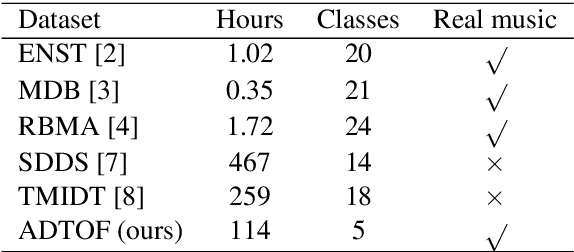

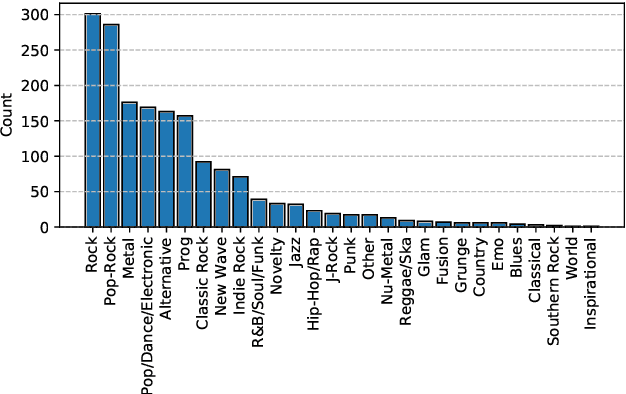
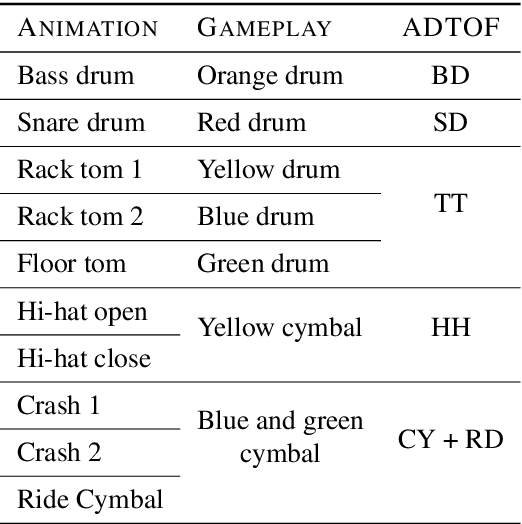
The state-of-the-art methods for drum transcription in the presence of melodic instruments (DTM) are machine learning models trained in a supervised manner, which means that they rely on labeled datasets. The problem is that the available public datasets are limited either in size or in realism, and are thus suboptimal for training purposes. Indeed, the best results are currently obtained via a rather convoluted multi-step training process that involves both real and synthetic datasets. To address this issue, starting from the observation that the communities of rhythm games players provide a large amount of annotated data, we curated a new dataset of crowdsourced drum transcriptions. This dataset contains real-world music, is manually annotated, and is about two orders of magnitude larger than any other non-synthetic dataset, making it a prime candidate for training purposes. However, due to crowdsourcing, the initial annotations contain mistakes. We discuss how the quality of the dataset can be improved by automatically correcting different types of mistakes. When used to train a popular DTM model, the dataset yields a performance that matches that of the state-of-the-art for DTM, thus demonstrating the quality of the annotations.
Global Structure-Aware Drum Transcription Based on Self-Attention Mechanisms
May 12, 2021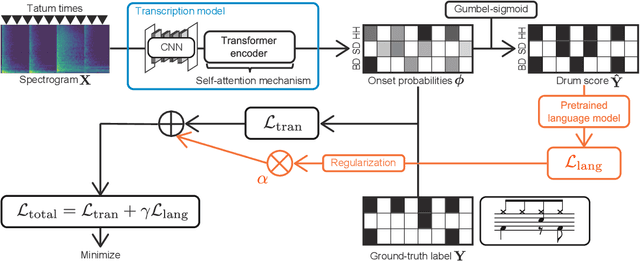


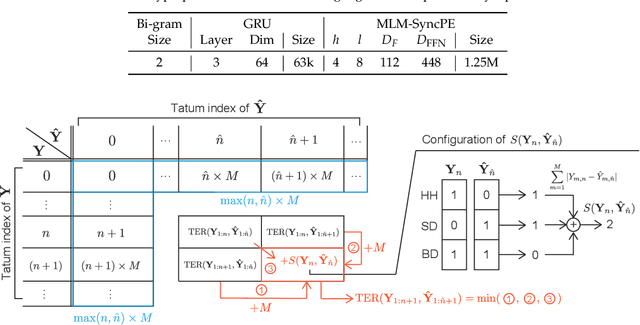
This paper describes an automatic drum transcription (ADT) method that directly estimates a tatum-level drum score from a music signal, in contrast to most conventional ADT methods that estimate the frame-level onset probabilities of drums. To estimate a tatum-level score, we propose a deep transcription model that consists of a frame-level encoder for extracting the latent features from a music signal and a tatum-level decoder for estimating a drum score from the latent features pooled at the tatum level. To capture the global repetitive structure of drum scores, which is difficult to learn with a recurrent neural network (RNN), we introduce a self-attention mechanism with tatum-synchronous positional encoding into the decoder. To mitigate the difficulty of training the self-attention-based model from an insufficient amount of paired data and improve the musical naturalness of the estimated scores, we propose a regularized training method that uses a global structure-aware masked language (score) model with a self-attention mechanism pretrained from an extensive collection of drum scores. Experimental results showed that the proposed regularized model outperformed the conventional RNN-based model in terms of the tatum-level error rate and the frame-level F-measure, even when only a limited amount of paired data was available so that the non-regularized model underperformed the RNN-based model.
Deep Embeddings for Robust User-Based Amateur Vocal Percussion Classification
Apr 10, 2022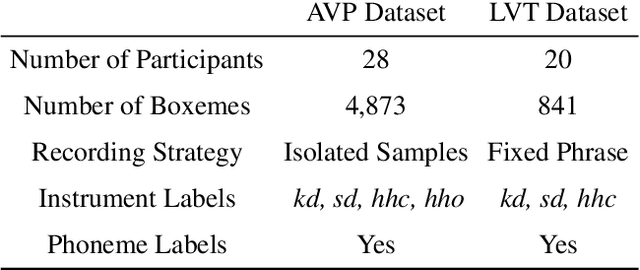
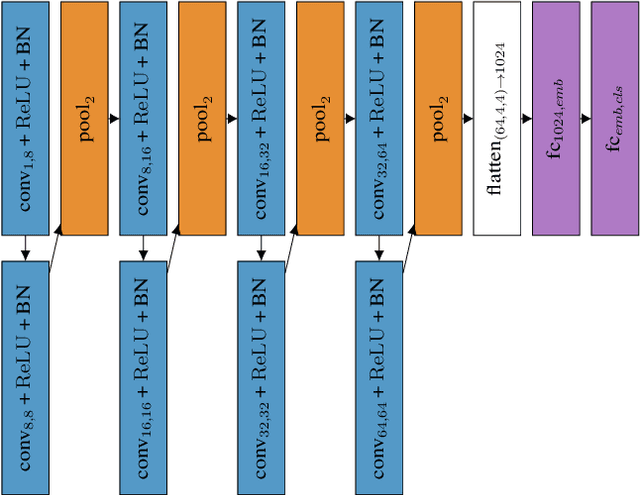


Vocal Percussion Transcription (VPT) is concerned with the automatic detection and classification of vocal percussion sound events, allowing music creators and producers to sketch drum lines on the fly. Classifier algorithms in VPT systems learn best from small user-specific datasets, which usually restrict modelling to small input feature sets to avoid data overfitting. This study explores several deep supervised learning strategies to obtain informative feature sets for amateur vocal percussion classification. We evaluated the performance of these sets on regular vocal percussion classification tasks and compared them with several baseline approaches including feature selection methods and a speech recognition engine. These proposed learning models were supervised with several label sets containing information from four different levels of abstraction: instrument-level, syllable-level, phoneme-level, and boxeme-level. Results suggest that convolutional neural networks supervised with syllable-level annotations produced the most informative embeddings for classification, which can be used as input representations to fit classifiers with. Finally, we used back-propagation-based saliency maps to investigate the importance of different spectrogram regions for feature learning.
 Add to Chrome
Add to Chrome Add to Firefox
Add to Firefox Add to Edge
Add to Edge